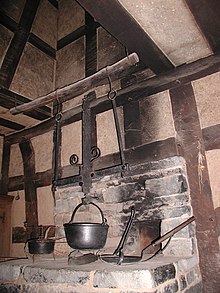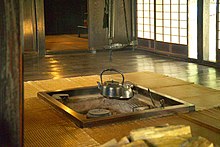Hearth

A hearth (
Before the industrial era, a common design was to place a hearth in the middle of the room as an open hearth, with the smoke rising through the room to a smoke hole in the roof. In later designs which usually had a more solid and continuous roof, the hearth was instead placed to the side of the room and provided with a chimney.
In fireplace design, the hearth is the part of the fireplace where the fire burns, usually consisting of fire brick masonry at floor level or higher, underneath the fireplace mantel.
Archaeological features





The word hearth derives from an
Lined hearths are easily identified by the presence of
Hearth tax
In the
In England, a tax on hearths was introduced on 19 May 1662. Householders were required to pay a charge of two
A revision of the Act in 1664 made the tax payable by all who had more than two chimneys.
The tax was abolished by William III in 1689 and the last collection was for Lady Day of that year. It was abolished in Scotland in 1690.[3]
Hearth tax records are important to
Published lists are available of many returns and the original documents are in the Public Record Office. The most informative returns, many of which have been published, occur between 1662–1666 and 1669–1674.
Religion and folklore
In Greek mythology, Hestia is the goddess of the hearth, while in Roman mythology Vesta has the same role.[4]
In ancient Persia, according to Zoroastrian traditions, every house was expected to have a hearth for offering sacrifices and prayers.[5]
In traditional Albanian folk beliefs, the Vatër, the home hearth, is a spiritual link between past, present, and future generations of the tribe, linking ancestors to the family today and to descendants tomorrow.
Hearth is also a term for a family unit, or local worship group, in the Heathen religion.[citation needed]
See also
- Agungi
- Brazier
- Buttumak
- Cook stove
- Firebox (architecture)
- Fireplace
- Firepit
- Forge
- Hall house
- Hibachi
- Inglenook
- Irori
- Kitchen
- Vesta – Goddess of the hearth
References
- ^ "*ker- | Etymology of root *ker- by etymonline". www.etymonline.com. Retrieved 25 February 2024.
- ^ Haldon, John F. (1997). Byzantium in the Seventh Century: the Transformation of a Culture. Cambridge University Press.
- ^ a b Gibson, Jeremy. The Hearth Tax, other later Stuart Tax Lists, and the Association Oath Rolls. Federation of Family History Societies.
- ISBN 1576072266
- ISBN 9004088474
